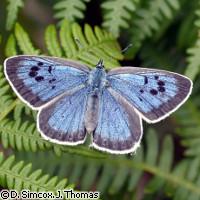How the Large Blue butterfly was brought back from the brink of destruction
Scientists in the UK identified the cause of the near-extinction of the Large Blue (Maculinea arion) butterfly, and successfully reversed the problem. Published in the journal Science, their resolution of a long-standing problem has provided valuable tools for other insect conservation projects. Their achievements were in part an outcome of the MACMAN ('Maculinea butterflies of the habitats directive and European red list as indicators and tools for habitat conservation and management') project, funded with EUR 3 million under the 'Energy, environment and sustainable development' Thematic area of the Fifth Framework Programme (FP5) to analyse the role of five highly endangered European butterflies as indicators for grassland biodiversity. After beginning its long population decline in the mid-1800s and a more dramatic drop-off after 1950, the Large Blue became one of three butterfly species identified in 1974 as a 'global flagship' for butterfly conservation. Representing the longest-running of the conservation initiatives, the species reached national extinction in the UK in 1979. According to the authors, as early as 1931 efforts were made to protect local populations by building fences to keep out butterfly collectors. Unfortunately, this also had the effect of keeping out the herbivores that maintained part of the Large Blues' specialised habitat. Professor Jeremy Thomas of the University of Oxford and the Centre for Ecology and Hydrology in the UK and his colleagues started their work in the early 1970s, seeking to understand the decline of the Large Blue on sites that appeared to be unchanged; this work was carried out in the last remaining stronghold of the butterfly, on Dartmoor, which is protected by National Park status. They found that ants were behind the population changes. The Large Blue butterfly depends on a single ant species (Myrmica) for its propagation. The female butterflies lay their eggs on thyme flowers; after hatching, the caterpillars eventually fall to the ground where they secrete chemicals that attract the ants, which take the caterpillars for ant grubs. The ants then carry the caterpillars into their nests and look after them for a crucial 10 months. In early June, the caterpillars form a chrysalis near the colony entrance and then emerge to crawl above ground two weeks later as butterflies. The researchers eventually observed that the grass in the butterflies' habitat had grown too long. Farmers had gradually stopped grazing their livestock there and the wild rabbits, falling victim to a viral infection in the 1950s, had stopped nibbling the grass. When the ants' habitat became overgrown, soil temperatures dropped and the ant population diminished. Large Blues, in turn, declined. The extreme dependence of the butterfly on the ants was not fully appreciated until fairly recently. 'Human beings are so much larger than insects; it's very hard for us to appreciate that what to us is an imperceptible change in habitat can have devastating consequences for a species like the bizarre and beautiful Large Blue butterfly. A difference of a centimetre in grass length can change the soil temperature by 2 or 3 degrees Celsius. If you're the size of an ant or butterfly, that difference is massive,' explained Professor Thomas. The data collected between 1972 and 1977 have just been published following the successful re-establishment of Large Blues in the UK thanks to an M. arion population imported from Öland, Sweden. This is one of only three butterfly species in the UK that is expected to meet the Convention of Biological Diversity's target to reverse species' declines by 2010. The scientists have also presented a numerical model that integrates all of the relevant ecological relationships. The model successfully predicted butterfly numbers 10 to 20 years ahead. 'The life-cycle data and the life tables generated a model upon which all our conservation efforts were based. The description of this model is also new. There are few known examples of a model being able to predict the success of a conservation effort as well as ours did, for any insect,' Professor Thomas said. Starting in 1983, the research team began introducing Large Blues into restored habitat sites. In 2008, the butterfly colonies were significantly larger and more abundant than they had been in the 1950s. According to the study, 'today, successful but smaller-scale management is being applied in other nations based on UK results, and M. arion's global listing has changed from Vulnerable to Near-Threatened'. The publication of this long-term study provides valuable data and tools for scientists working on restoring other butterfly species. Four related varieties of large blue butterflies are globally threatened, and the approach taken by Professor Thomas and colleagues has benefitted attempts to restore their numbers. A community approach to species conservation is advisable, the authors write. 'Since many other threatened species increased on UK sites following targeted management for M. arion,' the study concludes, 'we consider that successful species-based and community conservation for insects represent different routes to the same end.'
Countries
United Kingdom



